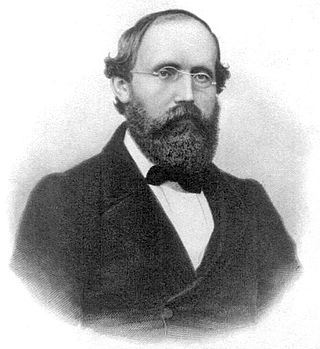
Differential geometry is a mathematical discipline that studies the geometry of smooth shapes and smooth spaces, otherwise known as smooth manifolds. It uses the techniques of differential calculus, integral calculus, linear algebra and multilinear algebra. The field has its origins in the study of spherical geometry as far back as antiquity. It also relates to astronomy, the geodesy of the Earth, and later the study of hyperbolic geometry by Lobachevsky. The simplest examples of smooth spaces are the plane and space curves and surfaces in the three-dimensional Euclidean space, and the study of these shapes formed the basis for development of modern differential geometry during the 18th and 19th centuries.

Georg Friedrich Bernhard Riemann was a German mathematician who made profound contributions to analysis, number theory, and differential geometry. In the field of real analysis, he is mostly known for the first rigorous formulation of the integral, the Riemann integral, and his work on Fourier series. His contributions to complex analysis include most notably the introduction of Riemann surfaces, breaking new ground in a natural, geometric treatment of complex analysis. His 1859 paper on the prime-counting function, containing the original statement of the Riemann hypothesis, is regarded as a foundational paper of analytic number theory. Through his pioneering contributions to differential geometry, Riemann laid the foundations of the mathematics of general relativity. He is considered by many to be one of the greatest mathematicians of all time.

The Large Scale Structure of Space–Time is a 1973 treatise on the theoretical physics of spacetime by the physicist Stephen Hawking and the mathematician George Ellis. It is intended for specialists in general relativity rather than newcomers.
In the mathematical field of differential geometry, the Riemann curvature tensor or Riemann–Christoffel tensor is the most common way used to express the curvature of Riemannian manifolds. It assigns a tensor to each point of a Riemannian manifold. It is a local invariant of Riemannian metrics which measures the failure of the second covariant derivatives to commute. A Riemannian manifold has zero curvature if and only if it is flat, i.e. locally isometric to the Euclidean space. The curvature tensor can also be defined for any pseudo-Riemannian manifold, or indeed any manifold equipped with an affine connection.
Riemannian geometry is the branch of differential geometry that studies Riemannian manifolds, defined as smooth manifolds with a Riemannian metric. This gives, in particular, local notions of angle, length of curves, surface area and volume. From those, some other global quantities can be derived by integrating local contributions.

William Kingdon Clifford was a British mathematician and philosopher. Building on the work of Hermann Grassmann, he introduced what is now termed geometric algebra, a special case of the Clifford algebra named in his honour. The operations of geometric algebra have the effect of mirroring, rotating, translating, and mapping the geometric objects that are being modelled to new positions. Clifford algebras in general and geometric algebra in particular have been of ever increasing importance to mathematical physics, geometry, and computing. Clifford was the first to suggest that gravitation might be a manifestation of an underlying geometry. In his philosophical writings he coined the expression mind-stuff.
In mathematics, the Chern theorem states that the Euler–Poincaré characteristic of a closed even-dimensional Riemannian manifold is equal to the integral of a certain polynomial of its curvature form.

Eugenio Beltrami was an Italian mathematician notable for his work concerning differential geometry and mathematical physics. His work was noted especially for clarity of exposition. He was the first to prove consistency of non-Euclidean geometry by modeling it on a surface of constant curvature, the pseudosphere, and in the interior of an n-dimensional unit sphere, the so-called Beltrami–Klein model. He also developed singular value decomposition for matrices, which has been subsequently rediscovered several times. Beltrami's use of differential calculus for problems of mathematical physics indirectly influenced development of tensor calculus by Gregorio Ricci-Curbastro and Tullio Levi-Civita.
In the mathematical field of differential geometry, Ricci-flatness is a condition on the curvature of a Riemannian manifold. Ricci-flat manifolds are a special kind of Einstein manifold. In theoretical physics, Ricci-flat Lorentzian manifolds are of fundamental interest, as they are the solutions of Einstein's field equations in a vacuum with vanishing cosmological constant.
In differential geometry and mathematical physics, an Einstein manifold is a Riemannian or pseudo-Riemannian differentiable manifold whose Ricci tensor is proportional to the metric. They are named after Albert Einstein because this condition is equivalent to saying that the metric is a solution of the vacuum Einstein field equations, although both the dimension and the signature of the metric can be arbitrary, thus not being restricted to Lorentzian manifolds. Einstein manifolds in four Euclidean dimensions are studied as gravitational instantons.

Geometry of Complex Numbers is an undergraduate textbook on geometry, whose topics include circles, the complex plane, inversive geometry, and non-Euclidean geometry. It was written by Hans Schwerdtfeger, and originally published in 1962 as Volume 13 of the Mathematical Expositions series of the University of Toronto Press. A corrected edition was published in 1979 in the Dover Books on Advanced Mathematics series of Dover Publications (ISBN 0-486-63830-8), including the subtitle Circle Geometry, Moebius Transformation, Non-Euclidean Geometry. The Basic Library List Committee of the Mathematical Association of America has suggested its inclusion in undergraduate mathematics libraries.

Calculus on Manifolds: A Modern Approach to Classical Theorems of Advanced Calculus (1965) by Michael Spivak is a brief, rigorous, and modern textbook of multivariable calculus, differential forms, and integration on manifolds for advanced undergraduates.

General Relativity is a graduate textbook and reference on Albert Einstein's general theory of relativity written by the gravitational physicist Robert Wald.
Geometry is a branch of mathematics concerned with properties of space such as the distance, shape, size, and relative position of figures. Geometry is, along with arithmetic, one of the oldest branches of mathematics. A mathematician who works in the field of geometry is called a geometer. Until the 19th century, geometry was almost exclusively devoted to Euclidean geometry, which includes the notions of point, line, plane, distance, angle, surface, and curve, as fundamental concepts.

Gerhard Huisken is a German mathematician whose research concerns differential geometry and partial differential equations. He is known for foundational contributions to the theory of the mean curvature flow, including Huisken's monotonicity formula, which is named after him. With Tom Ilmanen, he proved a version of the Riemannian Penrose inequality, which is a special case of the more general Penrose conjecture in general relativity.

Viewpoints: Mathematical Perspective and Fractal Geometry in Art is a textbook on mathematics and art. It was written by mathematicians Marc Frantz and Annalisa Crannell, and published in 2011 by the Princeton University Press (ISBN 9780691125923). The Basic Library List Committee of the Mathematical Association of America has recommended it for inclusion in undergraduate mathematics libraries.
Symmetry in Mechanics: A Gentle, Modern Introduction is an undergraduate textbook on mathematics and mathematical physics, centered on the use of symplectic geometry to solve the Kepler problem. It was written by Stephanie Singer, and published by Birkhäuser in 2001.
The Symmetries of Things is a book on mathematical symmetry and the symmetries of geometric objects, aimed at audiences of multiple levels. It was written over the course of many years by John Horton Conway, Heidi Burgiel, and Chaim Goodman-Strauss, and published in 2008 by A K Peters. Its critical reception was mixed, with some reviewers praising it for its accessible and thorough approach to its material and for its many inspiring illustrations, and others complaining about its inconsistent level of difficulty, overuse of neologisms, failure to adequately cite prior work, and technical errors.

Extrinsic Geometric Flows is an advanced mathematics textbook that overviews geometric flows, mathematical problems in which a curve or surface moves continuously according to some rule. It focuses on extrinsic flows, in which the rule depends on the embedding of a surface into space, rather than intrinsic flows such as the Ricci flow that depend on the internal geometry of the surface and can be defined without respect to an embedding.











